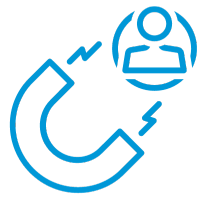 By Bre Alexander, Content Marketing Manager, iWave
By Bre Alexander, Content Marketing Manager, iWave
The past few years have undeniably posed challenges for nonprofits and fundraisers alike. We’ve come out of a global pandemic… but are we now heading into a recession? In this increasingly challenging environment, a series of shifts in the fundraising landscape have emerged:
- Donor retention rates are the lowest they’ve ever been, standing at just 42.6%.
- Dollars are down 3.4%, marking a year-over-year decrease that has only occurred four times in recent history.
- Donors are down, with less than 50% of households giving, a significant decline from the 1980’s which saw 80% of households giving.
- Donors are giving differently; 54% of millennials would give more if approached differently.
When economic uncertainty arises, nonprofits can face many potential challenges. The thought of a recession is daunting, but nonprofits can navigate these challenges by adopting strategic and adaptable fundraising approaches. Don’t fret; donors will always donate. The key lies in adapting your fundraising strategies to meet the evolving landscape so you can leverage opportunities during challenging times.
We’ve outlined some great strategies for your organization to adapt and prosper.
Strategy #1: Re-engage Existing Donors
 Donor retention rates are the lowest they’ve ever been at just 42.6%. Donor engagement and retention go hand in hand. Your best prospects are probably already in your database and have an established history with your organization. This makes evaluating and boosting your relationships with them easier and allows you to uncover new opportunities to retain and boost donations.
Donor retention rates are the lowest they’ve ever been at just 42.6%. Donor engagement and retention go hand in hand. Your best prospects are probably already in your database and have an established history with your organization. This makes evaluating and boosting your relationships with them easier and allows you to uncover new opportunities to retain and boost donations.
Screening a large number of your constituents can provide an excellent opportunity to segment your donors into prioritized lists of prospects who are most likely to donate. This info helps your team prepare appropriate gift asks, personalize cultivation, and maximize your organization’s fundraising potential. Screening also uncovers additional wealth, allowing you to recoup all or a portion of the recent decrease in dollars given.
Strategy #2 – Diversify Your Funding Sources
 With less than 50% of households giving, the old saying, “Don’t put all your eggs in one basket,” has never been more true. A well-diversified approach to funding sources will ensure you’re not leaving money on the table. One great place to start is by tapping into Foundation and Company giving.
With less than 50% of households giving, the old saying, “Don’t put all your eggs in one basket,” has never been more true. A well-diversified approach to funding sources will ensure you’re not leaving money on the table. One great place to start is by tapping into Foundation and Company giving.
There are several types of foundations, but let’s focus on private foundations for a moment. To maintain their 501(c)(3) status, foundations, unlike corporations, must give away five percent of their assets each year. They’re motivated to give and eager to find opportunities to fulfill that commitment.
Corporations are continuing to grow their giving programs. According to Giving USA’s 2022 Annual Report on Philanthropy, charitable giving grew by an estimated 23.8% to 21.08 billion in 2021. Adjusted for inflation, giving by corporations has increased by 18.3% in 2021 compared to 2020.
With the rise of Foundation and Corporate giving, the need for Foundation and Company screening is increasing. Like screening individuals, institutional screening provides segmentation and prioritization of a group of foundations or companies most likely to give to your cause.
Strategy #3 – Create Strong Donor Experiences
 The donor experience is everything; now is not the time to lose sight of your donor’s journey.
The donor experience is everything; now is not the time to lose sight of your donor’s journey.
Think about your experience with your favorite bands; the excitement they evoke and the appreciation they show you, their fan, keeps you coming back. Be mindful of providing these same positive feelings to your donors, and you’ll ensure a life-long fandom!
To keep your donors happy and engaged, thank them. It can really be that simple. 76% of consumers said that personalized communications was a key factor in prompting their consideration for a brand, and 78% said that personalized content made them more likely to repurchase (ie. donate). The same is true of your donors. Personalized thank you letters detailing their impact encourages them to continue to support your cause, or better yet, may lead them to increase their support!
When crafting your thank-you letter, consider following these to-dos.
- Be Intentional – use it as an opportunity to engage your donor
- Handwritten is best
- Make it personal – address your donor by their preferences
- Define the impact – Showcase how they made a positive impact
Like thank you letters, personalizing messaging to your constituents plays into the donor journey and retention. Your donors have already shown they love your organization. Ensure you treat them with the same love they’re showing you.
Strategy #4 Offer Unique Giving Opportunities
 We know donors are giving differently, how we ask donors to give needs to shift to meet their changing needs and wants. Meet your donors where they’re at and how they’re willing to donate.
We know donors are giving differently, how we ask donors to give needs to shift to meet their changing needs and wants. Meet your donors where they’re at and how they’re willing to donate.
Of course, some donors will gladly give cash gifts, and that’s fantastic. Don’t overlook that many donors are looking for new, more diverse ways to give. A few ideas include:
Crypto Giving: Cryptocurrency is a new asset class; many crypto holders want to donate a portion of their holdings to benefit nonprofits and receive tax benefits for donating an appreciated asset. The number of crypto-gifts is on the rise and is expected to grow in the coming years.
Impact Investing: Consider implementing impact investing strategies that allow donors to allocate their financial resources towards socially responsible projects that align with your organization’s mission.
Skill-Based Volunteering: Engage donors by providing opportunities to contribute their professional expertise to support your organization’s efforts. Leverage their specialized knowledge in areas such as marketing, legal advice, or consulting services.
While we may hit economic uncertainty, nonprofits can navigate the potential impacts and continue to receive support by adopting strategic fundraising strategies. With these strategies, nonprofits can remain resilient and seize growth opportunities.
Want even more helpful strategies? Get iWave’s Fundraising in a Recession: 7 Strategies to Raise More Money ebook!


